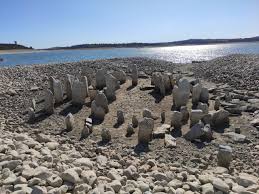Dolmen de Guadalperal also known as the Spanish Stonehenge just surfaced after being underwater for the last 50 years. In July, a NASA satellite image discovered the 7,000-year-old megalithic structure.
It’s not the first time Dolmen de Guadalperal is above water. German archeologist Hugo Obermaier discovered the giant stone structures in the 1920s. Obermaier did a lot of research on the structure back then but his Spanish Stonehenge report didn’t see the light of day until the 1960s.
According to Obermaier and NASA, the structure was an enclosed space. It was a large stone house-type structure with some sort of cap. Scientists believe it was a sight for religious ceremonies or it was a Neolithic tomb, according to Fox News.
If archeologists are right, the Spanish Stonehenge is as old as the English Stonehenge, but its location in the Valdecañas Reservoir keeps the site submerged most of the time. There is still a great deal to learn from the site. The stone that served as the entrance has a squiggly line running through it. Scientists believe the line represents the Tagus River or a snake. If the line does represent the Tagus River, it would be one of the oldest maps on Earth, according to NASA.
Some Spanish officials want to move the structure to higher ground due to the fact it will be underwater again in fall. But the plan is to keep the structure where it is and then find a way to continue to study its secrets.
The Spanish Stonehenge is not the only incredible discovery that changes the way Archeologists perceive the planet. Researchers discovered the lost continent of Adria buried under Southern Europe. It’s not Atlantis even though scientists say it is the size of Greenland. Adria broke off North Africa 140 million years ago, and it slid under the mantle of Southern Europe.
Adria isn’t the only lost continent found this century. In 2017, a continent that broke off from Gondwana, the supercontinent, had scientists scratching their heads when they found it covered in lava under Mauritius. Another 2017 research team found the continent Zealandia almost a mile below sea level in the South Pacific.









